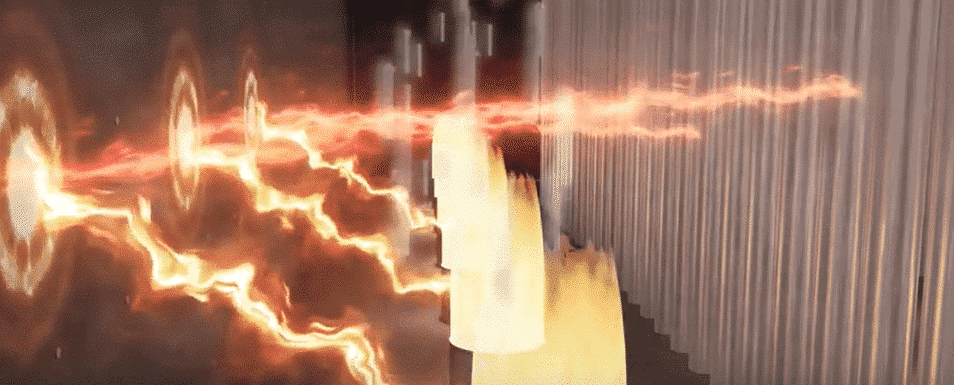The furnace walls in a radiant section of a Steam Methane Reformer (SMR) are lined with refractory, brick and fiber materials having relatively low emissivity. By applying the Cetek High Emissivity Coating on the surface of the furnace walls, it is possible to increase the refractory emissivity and thereby improve the reformer efficiency significantly by increasing the thermal efficiency of the furnace box.
The enhanced efficiency of the furnace box can be utilized to alleviate excessive temperatures in the convection section, increase the capacity of the steam reformer or extend the lifetime of the catalyst tubes. Several other secondary benefits are obtained by sealing the refractory walls with the ceramic coating material. The coating has been utilized successfully in syngas reformers of different designs in ammonia, methanol and hydrogen production facilities.

The thermal efficiency of the SMR is typically 45-60%, and an additional 35-50% of the heat is recovered from the flue gas in the reformer convection section. The recovered heat is used for preheating of reformer feed, process air, steam superheating, and preheating of boiler feed water or combustion air.
The thermal efficiency of the furnace box can be increased by applying a high emissivity ceramic coating on the furnace walls which enhances the radiant heat transfer contribution from the hot furnace walls to the catalyst tubes. However, the efficiency improvement depends on the reformer design and the actual operating conditions in the reformer.
The more uniform and higher radiant heat transfer contribution from the furnace walls makes the sidewall fired and the terrace wall fired reformers superior with respect to utilization of enhanced radiation from the furnace walls.
High emissivity surfaces radiate energy across a broad wavelength band, lessening the interference of the CO2 and H2O in the flue gas.
When the radiation from a flame strikes a perfect radiator, all of the energy is absorbed, but most importantly, it is transformed into “black body radiation,” as the broad waveband form. As the energy is re-emitted from the refractory surface, it is able to penetrate the atmosphere in the furnace, composed of the combustion products, with little being reabsorbed and taken to the stack by the draft.
Therefore, it is more readily available to heat the load in the steam methane reformer.
If the surface were a poor radiator, or one having a very low emissivity value, the energy striking the refractory surface would be reflected back from the refractory still in its untransformed state, therefore more readily absorbed by the flue gas, resulting in wasted energy lost to the stack.
The improvement in radiant heat transfer efficiency leads to a reduction in flue gas temperature. This has consequences in the convective heat transfer in the convection sections of the primary reformer. In the convection section, heat in the flue gas is used to produce steam and preheating of combustion air process fluids. We carefully examine the heat transfer/absorbed duty balance to ensure that the balance is not adversely affected.
IGS is here to provide information, answer questions and create an effective solution for your needs.
Cetek’s high emissivity ceramic coatings applied to the refractory surfaces provide a significant effect, which varies for different types and designs of hydrogen, ammonia and methanol reformers. In order to derive the most benefit, it is essential that a complete technical analysis/evaluation of the effects of the application is completed beforehand. The benefit in the radiant section and the effects on the convection section are studied and reported before any commitment is made by the client or IGS/Cetek.
Typical approved applications in steam methane reformers show productivity benefits (as energy savings or production increase) ranging from 1.0% to 5.0%.
The reduction in flue gas temperature leads to a significant reduction in thermal NOx emissions. The typical reduction in NOx emissions in steam methane reformers is 20% to 30%, irrespective of burner type. CO2 emissions are reduced proportionately with the productivity benefits – with gas consumption reduction.
Cetek’s ceramic coatings (high emissivity or neutral emissivity) provide encapsulation of ceramic fiber (blanket, modules, or panel) insulation. When coated, there is no loss of friable fiber from radiant sections. Therefore, no fouling of radiant section tubes/catalyst tubes, convection section tubes, screens of SCR (Selective Catalytic Reduction) units or loss to the environment through the stack.
The expected benefits from coating have been realized in many fired heaters and reformers. The typical 1.0-5.0% capacity increase or energy savings provide a significant benefit. Combined with more uniform heat flux and heat transfer from re-radiating refractory surfaces, lower bridgewall temperature and emissions, this technology makes a meaningful contribution to the overall reformer performance.
The performance life of the coating system applied to a refractory surface of the Steam Methane Reformer is related to the furnace box temperature and exposure to localized flame impingement. The extended lifetime benefit is typically 6-8 years, after which we can reapply the coating to regain the maximum performance.
Furnace Efficiency Specialist Larry Emch recalls an application where IGS reduced SMR fuel consumption by 2%, leading to lower CO2 and NOx emissions.
This sustainable decade-long benefit was achieved with the application of a Cetek refractory encapsulation coating within the SMR’s radiant section.
IGS is here to provide information, answer questions and create an effective solution for your needs.
